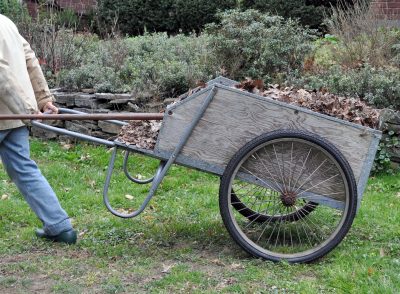CLOSING “SHOP”
/10 Comments/in Fruit, Gardening, Vegetables/by Lee ReichChips, Not Hay, In This Case
“Make hay while the sun shines.” Good advice, literally in agriculture and figuratively in life. And I’m following it these days, in agriculture. Not making hay of course, because that sunshine is only effective in summer and fall, partnered with heat.
The “hay that I’m making” is actually mulch that I’m spreading. A few weeks ago I put my “WOOD CHIPS WANTED” sign out along the road in front of my house. In a short time, an arborist was kind enough deposit a truckload of chips. 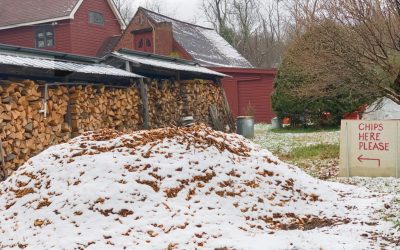 I figured I could spread it on the ground beneath some of my trees and shrubs, especially the youngest ones. There, next summer, the mulch would keep weeds at bay, slow evaporation of water from the ground, and feed soil life, in so doing enriching the soil with nutrients and organic matter.
I figured I could spread it on the ground beneath some of my trees and shrubs, especially the youngest ones. There, next summer, the mulch would keep weeds at bay, slow evaporation of water from the ground, and feed soil life, in so doing enriching the soil with nutrients and organic matter.
Usually, by this time of year, my piles of wood chips have frozen solid or are white mounds beneath snowy blankets. Not so this year.
So I’ve been loading up garden cart after garden cart with chips to haul over to the garden. (Once the ground disappears beneath a heavy, white layer of snow, moving heavy cartloads becomes nearly impossible.)
Since the most important trees and shrubs had already been mulched earlier in autumn, I decided it was a good time to add a layer of chips to the paths in the vegetable garden.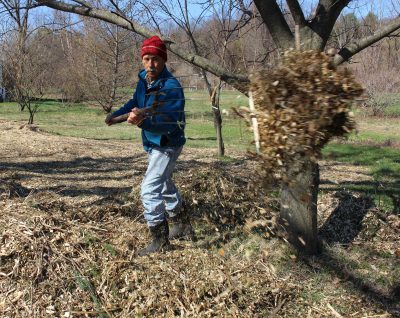 Chips there are mostly to suppress weeds which thrived with last season’s unusually abundant rainfall and to soften, by spreading out, the impact of footfall on the paths. I generally “chip the paths” every couple of years at a minimum if for nothing more so that the height of the paths keeps up with the rising height of the vegetable beds which get — and already got, at the end of this season — a one-inch deep blanket of compost annually. (Besides the usual benefits of mulches, the compost provides enough nutrients for the intensively planted vegetables for the whole season. No fertilizer per se is needed.)
Chips there are mostly to suppress weeds which thrived with last season’s unusually abundant rainfall and to soften, by spreading out, the impact of footfall on the paths. I generally “chip the paths” every couple of years at a minimum if for nothing more so that the height of the paths keeps up with the rising height of the vegetable beds which get — and already got, at the end of this season — a one-inch deep blanket of compost annually. (Besides the usual benefits of mulches, the compost provides enough nutrients for the intensively planted vegetables for the whole season. No fertilizer per se is needed.)
After decades of my adding an inch or more of wood chips to the paths and compost to the beds, you might suppose that the whole vegetable garden has risen a few feet above the surrounding area like a giant stage. Nope. The goodness of organic materials, such as the compost and wood chips, comes from soil organisms chewing them up and breaking them down. As decomposition takes place, the bulk of these materials, which are mostly carbon, hydrogen, and oxygen, is released into the air as carbon dioxide and water. The minerals that remain feed the plants.
Pine Berries?
One bed in the vegetable garden is home to strawberries. That bed also needs mulching, for different reasons and with different materials than the other beds, and needs it every year about now.
A strawberry plant is mostly nothing more than a stem, a stem whose distance from leaf to leaf has been telescoped down to create a stubby plant.  Like the stems of any other plant, a strawberry stem each year grows longer from its tip and also grows side shoots. So a strawberry stem rises ever so slowly higher up out of the soil each year.
Like the stems of any other plant, a strawberry stem each year grows longer from its tip and also grows side shoots. So a strawberry stem rises ever so slowly higher up out of the soil each year.
Strawberry stems are not super cold-hardy. As a stem slowly rises higher in the ground, it’s exposed to more and more cold, and more apt to dry out.
What’s needed is to protect the stems with an insulating blanket of some loose organic material. Straw is traditional — and one possible root of the name “strawberry” — but good straw reliably free of weed seeds is hard to find. Instead of straw, I often use wood shavings, conveniently available in bagged bales. This year I decided that the giant pine tree here could spare a few pine needles, raked up to share with the strawberries.
The goal of mulching strawberries isn’t to keep cold out, just to moderate the bitterest cold. 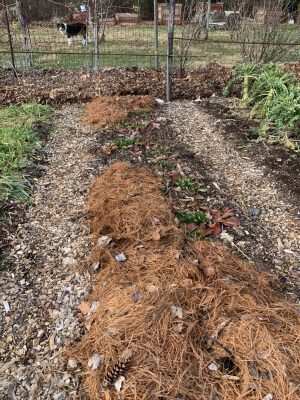 Mulching too early might cause the stems to rot. I typically wait until the ground has frozen about an inch deep which usually occurs towards the end of December here, and then cover the plants with about an inch depth of wood shavings.
Mulching too early might cause the stems to rot. I typically wait until the ground has frozen about an inch deep which usually occurs towards the end of December here, and then cover the plants with about an inch depth of wood shavings.
Come spring, the mulch needs to be pulled back before the plants start growing. Tucking the mulch in among the plants provides the usual benefits of mulch, especially important for strawberries because of their shallow roots, and provides a nice, clean bed on which the ripening berries can lie.
(More about growing strawberries can be found in my book GROW FRUIT NATURALLY.)
Hey, Good Looking
I admire the look of my vegetable gardens this time of year. With the chipped paths and compost lathered beds, some also with a tan cover of winter-killed oat plants, they look very tidy and ready to welcome new seeds and transplants in the months ahead. The look doesn’t compare with the lush greenery and colorful fruits of the summer garden, all of which is nothing more than a memory.

FINAL HARVESTS
/10 Comments/in Books, Fruit, Vegetables/by Lee ReichCompressed Gardening Experience
People are so ready to sit at the feet of any long-time gardener to glean words of wisdom. I roll my eyes. Someone who has gardened for ten, twenty, even more years might make the same mistakes every year for that number of years. I, for instance, swung a scythe wrong for 20 years; I may have it right now. Even a wizened gardener who has evaluated and corrected their mistakes has garnered experience only on their own plot of land; these experience may not apply to the differing soils, climates, and resources of other sites.
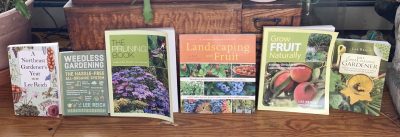
When I began gardening, my agricultural knowledge and experience was nil, zip, niets, rien, nada. But — and this is important — I had easy access to a whole university library devoted solely to agriculture. Hungry to learn, I read a lot. (I also was taking classes in agriculture.) In one year I was able to garner years of, if not actual experience, much of the knowledge that comes with that experience. And my garden showed it.
I’ve now gardened many decades and still gobble up the written word.
All of which is to say that reading reputable sources about gardening can make anyone a much better gardener and do so quicker than by gardening alone. “Reputable” is a key word in the previous sentence. So here’s the, to use the phrase of Magliozzi brothers on the radio show Cartalk, Shameless Commerce Division of this blog: a plug for my books. I stand firmly by anything I’ve written and am open to criticism.
Here’s the book list, all available from the usual sources or, signed, from me through this website (good gift idea, also):
•A Northeast Gardener’s Year: A month by month romp through all things garden-wise, what to do, how to do it, and when to do it.
•The Pruning Book: Plant responses, pruning tools, how to prune just about every plant (indoor, outdoor), and final sections on specialized pruning techniques, such as scything and espalier.
•Weedless Gardening: A four-part system, emulating Mother Nature and based on current agricultural research, that makes for less weeds and healthier plants, along with other benefits such as more efficient use of water and conservation of humus.
•Landscaping with Fruit: Following introductory chapters about designing your landscape is a listing of the best fruits to use for “luscious landscaping” in various regions and how to grow each of these fruiting trees, shrubs, vines, and groundcovers.
•Grow Fruit Naturally: Describes multi-faceted approaches to growing fruits without resorting to toxic sprays, starting with selecting kinds of fruits and varieties and moving on to encouraging natural predators, beefing up the soil, and more.
•The Ever Curious Gardener: Using a Little Natural Science for a Much Better Garden: Knowing some of the science behind what’s going on in the garden can make you an even better gardener; here’s how.
Vegetable Finale
And now, on to some gardening . . .
I’ve said it before and Yogi Berra said it before me, “It ain’t over till it’s over.” Last night’s temperature plummeting to 18°F was still not enough to put the brakes on the vegetable garden. Beneath their covered “tunnels,” arugula, mustard, endive, and napa Chinese cabbage still thrive. Along with mâche and kale, which aren’t under cover, all these greens are looking as perky as ever and, most important, taste better than ever.
Interestingly, temperatures I’ve measured within the tunnels are not that different — actually, not different at all — from temperatures I’ve measured outdoors. But something’s different. The increased humidity under the tunnels is probably at least partially responsible for the fresh tastes and appearances.
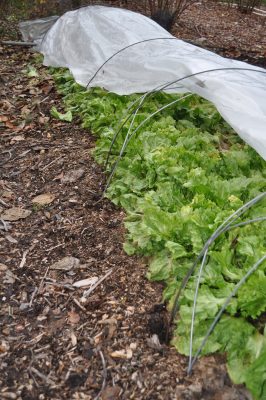
It’s a wonder that these tender, succulent leaves tolerate such temperatures. You’d think the liquid in their cells would freeze and burst the contents to smithereens. That would have been the case if the 18°F had come on suddenly, without any precedents.
Plants aren’t passive players in the garden. Increasingly cold weather and shortening days acclimated these plants to cold. (A month ago, temperatures dropped one night to 16°F.) Plants move water in and out of their cells, as needed, to avoid freezing injury. And increasing concentrations of dissolved minerals and sugars in the cells make the water freeze at lower temperatures. Perhaps that’s one reason why these vegetables taste so good. The tunnels also slow down swings in temperature, giving plants time to move water in and out of their cells and whatever else they do preparing for and recovering from cold.
Too many people, even gardeners(!), consider endive as nothing more than a bitter, green leaf best used as garnish. Reconsider. Given close spacing so that inner leaves of each head blanche from low light along with cool and cold temperatures, and endive takes on a wonderful, rich flavor. 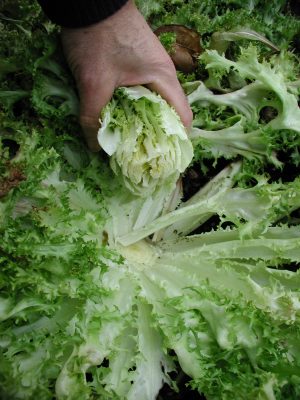 Only the slightest hint of bitterness remains, enough to make the taste more lively — delicious in salads, soups, and sandwiches.
Only the slightest hint of bitterness remains, enough to make the taste more lively — delicious in salads, soups, and sandwiches.
Fruit Finale
The last fruits of the season, Szukis American persimmon, were harvested last week after over a month of eating them. Definitely the easiest fruit I grow. No pruning, no pest control. And definitely one of the tastiest: imagine a dried apricot soaked in water, dipped in honey, then given a dash of spice.

Fruits were very mushy for the final harvests — perfect for a jam. Squeezing a bunch of the fruits in a mesh bag (such as used for women’s “delicates” in a washing machine) pushed out 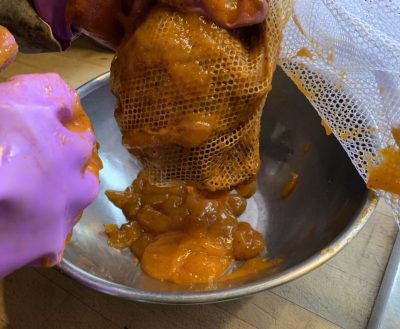 the pulp without seeds. No sweetener needed. Just jar it up and refrigerate (keeps about 2 weeks) or freeze. Delicious.
the pulp without seeds. No sweetener needed. Just jar it up and refrigerate (keeps about 2 weeks) or freeze. Delicious.
GARDEN ESSENTIALS, FOR PEGGY
/7 Comments/in Books, Vegetables/by Lee ReichCompost, of Course, and More
Very soon I plan to drive a truckload of compost to my sister Peggy’s house. Like many people, she’s caught the gardening bug, and this compost, along with a wheelbarrow I fished out of my town’s metal recycling, is a gift. It includes my help spreading it.
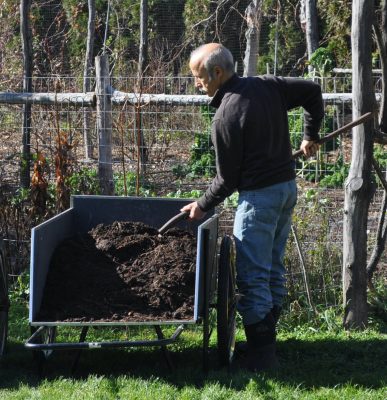
What else would be a good gift for any beginning gardener? (Okay, Peggy has been dipping her toes in the gardening waters for years, but only recently got more serious about growing vegetables.)
For starters, indispensable, would be a trowel or a hori-hori knife, the latter being something of a hybrid of a garden knife and a trowel, not as good as either parent but great for all-around use. No need to labor over the worth of a high-end, stainless steel, oak-handled trowel; either will work well and last long if stored out of the elements.
A pair of hand shears would come in handy for clipping tomato suckers or cutting down pepper or eggplant plants at season’s end. They’e admittedly not indispensable for vegetable gardening but very useful if any shrubs or trees are also in the picture.  For a hand shears, quality counts. Blades of the best hand shears, as in their name, shear past each other like those of scissors. They’re called “bypass pruners.” My favorite is the ARS hand shears. Shears with anvil blades — “anvil pruners” — sport a sharp blade that comes down on a narrow, flat surface; the flat surface limits how close you can make a cut and the shear works poorly if any nick or waviness develops on the sharp blade.
For a hand shears, quality counts. Blades of the best hand shears, as in their name, shear past each other like those of scissors. They’re called “bypass pruners.” My favorite is the ARS hand shears. Shears with anvil blades — “anvil pruners” — sport a sharp blade that comes down on a narrow, flat surface; the flat surface limits how close you can make a cut and the shear works poorly if any nick or waviness develops on the sharp blade.
For anyone venturing into growing their own seedlings, which greatly widens the choices of varieties to grow, I recommend one of the many “self watering seed starters.” Cells housing plants sit on a capillary mat that dips into a water reservoir just below. 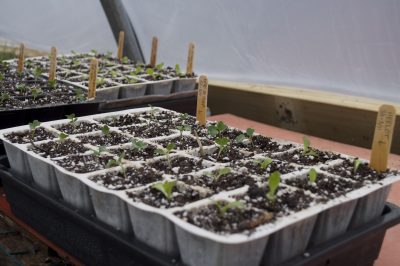 Soil in the cells sucks up moisture from below through capillary action to remain consistently moist, and the reservoir requires replenishment infrequently.
Soil in the cells sucks up moisture from below through capillary action to remain consistently moist, and the reservoir requires replenishment infrequently.
And finally, gloves, although these are very personal and it’s hard to pick out a pair suited to anyone else besides yourself. How about money for gloves? And some people like to get their hands in the dirt. As a professional pianist and piano teacher, probably not Peggy (check her out at www.peggyreich.com).
Reading Can Substitute for Years of Gardening
Okay, moving on to a most important “tool” for beginning, even intermediate and advanced, gardeners alike: books and the web. That is, if the information offered is sound — not always the case. One way to get solid information off the web is to follow any search term(s) with “site:edu” or “site:gov”, which brings you to university or government sites, respectively.
Not that those are the only reputable sites, but then judge whether other sites are reputable based on the author(s), possible agendas for financial gain, and comparing other information on the site with that you know for sure is either correct or false.
As an example, someone recently told me that black walnut plants are high in iodine, as evidenced by the brown stain from the hulls and the first of many hits if you enter “iodine” and “black walnut” into a search engine. This didn’t ring true to me so I looked up analyses of iodine concentrations in black walnut on a number of reputable sites. No, black walnut plants do not contain iodine, despite all the sites touting the myth that they do.
(Everything you read on my site is, of course, reputable. Ha, ha.)
On to books . . . if I may be so bold as to begin by recommending my own. Weedless Gardening 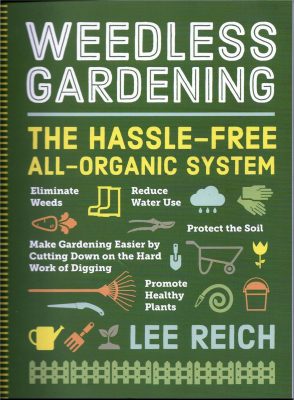 tells how to prepare and manage the soil, when to sow and transplant vegetables, what to use for mulch, how to make compost, the ins and outs of drip irrigation, and more. A Northeast Gardener’s Year
tells how to prepare and manage the soil, when to sow and transplant vegetables, what to use for mulch, how to make compost, the ins and outs of drip irrigation, and more. A Northeast Gardener’s Year  takes you on a timely jog through the year with all things gardening: soil, flowers, houseplants, naming plants, etc., depending on what needs doing gardenwise indoors and out. I’ve written more books (all are listed on this site), but these two are more essential.
takes you on a timely jog through the year with all things gardening: soil, flowers, houseplants, naming plants, etc., depending on what needs doing gardenwise indoors and out. I’ve written more books (all are listed on this site), but these two are more essential.
Plenty of other reputable gardening books are around if you seek them out. For an all around gardening book, check out Barbara Damrosch’s The Garden Primer. Specifically, for vegetables, there’s E. C. Smith’s The Vegetable Gardener’s Bible or some oldies, or, if you can get them, A. C. Burrage’s Burrage on Vegetables or Gardening: The Complete Guide to Growing America’s Favorite Fruits & Vegetables from the National Gardening Association.
Quality Compost?
Back to that truckload of compost for Peggy. A truckload of compost is more than I can spare of my own black gold, so I’m purchasing it in bulk.
I picked up the phone, dialed some numbers, and asked some prospective compost merchants about their products to make sure the compost would be of good quality. What went into the compost, for instance? A greater the variety of raw materials results in a better variety of nutrients in the end product as long as those raw materials don’t include industrial wastes that might contain heavy metals, or, in dry regions, feedlot manures, because of excess salts.
What about the acidity or pH? Ideally the pH lies between 6 and 7.
How rocky or stony is the compost? No need to pay for rocks rather than compost. Similarly, is the material pure compost (desired), or compost diluted with a large portion of soil?
How about weeds or weed seeds? Time, temperature, and pile turning all have bearing on the number of viable weed seeds in a finished compost. A carefully built compost pile easily reaches a high enough temperatures to kill most weed seeds. But even when weed-free initially, composts that sit around too long (especially if uncovered) will pick up weed seeds carried in by wind and animals.
Good gardening, and especially organic gardening, involves moving bulky organic materials such as hay, straw, wood chips, wood shavings, leaf mold, and compost. These organic materials are what feed the friendly soil microbes which, in turn, feed the plants, as well as beef up the soil ecosystem in many biological and physical ways.
So two other items that come to mind, after the trowel, pruning shears, seed starting flats, and books, are a wheelbarrow or garden cart, and pitchfork or shovel. As I wrote, I’ll leave the wheelbarrow with her and can also leave of the many pitchforks I’ve accumulated over the years. Have I forgotten to mention any other gardening essentials?